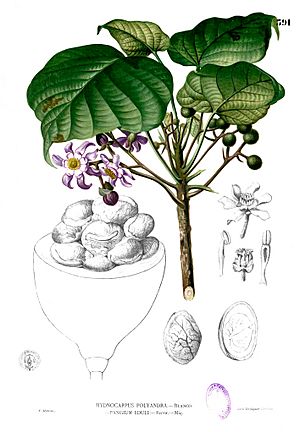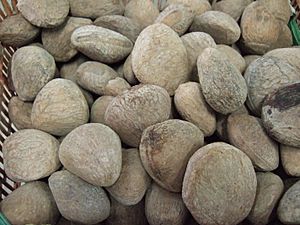Pangium facts for kids
Quick facts for kids Pangium |
|
|---|---|
 |
|
| Plate from book: Flora de Filipinas | |
| Conservation status | |
| Scientific classification | |
| Genus: |
Pangium
|
| Species: |
edule
|
| Nutritional value per 100 g (3.5 oz) | |
|---|---|
| Energy | 462 kJ (110 kcal) |
|
23.9 g
|
|
| Sugars | 14.1 g |
| Dietary fiber | 6.2 g |
|
2 g
|
|
|
Protein
|
2.3 g
|
| Vitamins | Quantity
%DV†
|
| Vitamin A equiv.
beta-Carotene
|
2%
19 μg
2%
230 μg |
| Vitamin C |
31%
25.8 mg |
| Minerals | Quantity
%DV†
|
| Calcium |
2%
15 mg |
| Iron |
17%
2.2 mg |
| Magnesium |
9%
32 mg |
| Manganese |
7%
0.155 mg |
| Phosphorus |
7%
52 mg |
| Potassium |
5%
151 mg |
| Sodium |
0%
4 mg |
| Zinc |
5%
0.43 mg |
|
Link to USDA Database entry
|
|
| †Percentages estimated using US recommendations for adults. | |
Pangium edule is a tall tree that grows in the swampy areas of Southeast Asia, like Indonesia and Papua New Guinea. It is the only species in its group, called Pangium. This tree produces a large fruit, sometimes called the "football fruit" or pangi.
The fruit and its seeds are naturally poisonous. However, people can make them safe to eat by using a special process called fermentation. This tree is also dioecious, which means it has separate male and female trees, each producing different flowers. Scientists are still learning about the exact family this tree belongs to.
Contents
What Does the Pangium edule Tree Look Like?
This tree can grow quite tall, reaching up to 18 meters (about 59 feet) high. Its leaves are shaped like a heart. The fruit is brownish and grows in bunches, looking a bit like a pear.
How is Pangium edule Grown?
The Pangium edule tree takes many years to grow big enough to produce fruit. Because of this, it's not usually grown on farms. Most of the seeds are collected from wild trees. Even though the seeds are poisonous to humans, they are a natural food source for an animal called the babirusa (Babyroussa babyroussa).
How are Pangium edule Seeds Used?
The fresh fruit and seeds of Pangium edule contain a dangerous substance called hydrogen cyanide. This means they are deadly if eaten without being prepared first.
To make the seeds safe to eat, people follow a special method:
- First, the seeds are boiled.
- Then, they are buried in ash, banana leaves, and earth for about forty days.
- During this time, the seeds change color from a creamy white to a dark brown or black.
This process works because the hydrogen cyanide released by boiling and fermentation can be easily washed out by water.
Once prepared, the kernels (the inside part of the seeds) can be ground into a thick, black sauce. This sauce is called rawon in some places. It's used in many popular dishes:
- In East and Central Java, nasi rawon is a well-known beef stew made with keluwek paste.
- Sambal rawon is another stew made with beef or chicken in East Java.
- In West Java and Jakarta, a traditional dish called gabus pucung uses snakehead fish in pucung paste soup.
- The Toraja people use the black keluak powder in their dish called pammarrasan, which is a black spice used with fish, meat, or vegetables.
- In Singapore and Malaysia, the seeds are a key ingredient in ayam (chicken) or babi (pork) buah keluak, which are important dishes in Peranakan cuisine.
- The Dusun tribe in Borneo use the pounded kernel to make a sour fermented fish dish called bosou.
People of the Minahasa tribe in North Sulawesi also use the young leaves of the Pangium edule tree as a vegetable. They slice the leaves and cook them with herbs and pork fat or meat inside bamboo. You can often find these leaves for sale in traditional markets, like in Tomohon.
Nutritional Benefits
The parts of the Pangium edule plant that can be eaten are a great source of vitamin C and are high in iron.
See also
 In Spanish: Pangium para niños
In Spanish: Pangium para niños



